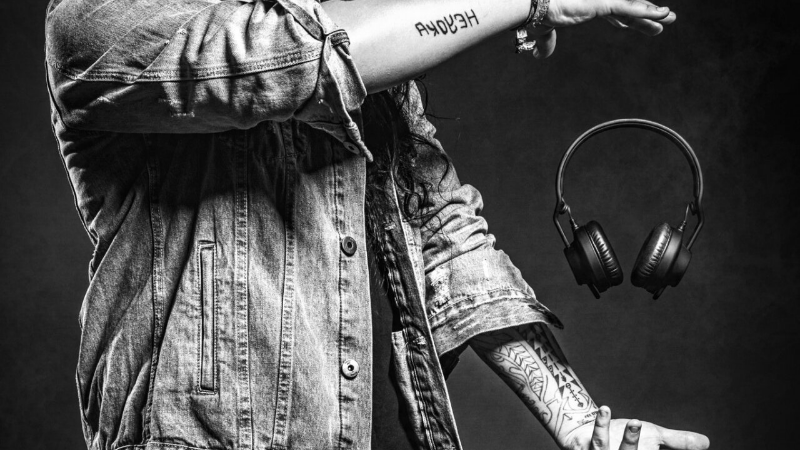
You have been writing songs for a while now, and you’re ready to take the big leap. One or two of those songs have you especially excited. So you’ve broken the swear jar and you’re heading into the studio to record them. The thing is, this is your first time doing anything like this and you’re a little shy about looking like a total rookie. There are things you’d like to know especially as a singer. The first and foremost is…
Why do singers use headphones when recording? A singer must sing along with an instrumental track or band when recording. Headphones are worn to prevent unnecessary noise from the instrumental track from bleeding into the microphone and onto the track the singer is recording.
Recording music starts with capturing clean source material. It is of the upmost importance to record each source without any additional unwanted noise. This will ensure that the tracking engineer has captured a quality vocal performance that is useable for the final mix.
A singer should certainly be wearing headphones when recording. They must be able to hear the backing track or the performance of their bandmates when they are recording their parts.
Additionally keep in mind that recording music is the act of capturing a timed event. So it is critical for everybody to be synchronized when playing. It is necessary to count bars and beats to keep time with one and other and it’s essential for anticipating your cues.
All of this information is communicated with sound. That sound needs to go into your ears and not into the mic. So be sure that the headphones are closed snuggly over them.
I hope the explanation makes sense. The first time going into a recording studio is an exciting experience.
In order to be sure you’re well prepared for your first day of recording, lets discuss a little more related to this topic. Specifically; what it is exactly that you will hear in the headphones and whether you have any control of what you’re hearing.
What We Hear In The Headphones
So when you finally put on the headphones and walk up to the microphone, the tracking engineer is going to check levels.
You will be able to hear your own vocals going into the microphone, monitored back to your headphones.
After the engineer has adjusted everything the way it’s needed you’ll be able to hear yourself as well as the backing track, or instrumental track.
You will also be able to hear the engineer and or producer talking to you from the Control Room directly into your ears through the headphones as well.
You can talk back to them with the microphone. This is a necessary function to coordinate a few different factors without having to run back and forth from room to room.
The Things They Might Discuss On The Headphones
The engineer will give you instructions related to what is needed to capture a good recording in the technical sense.
This may be to discuss what you’re hearing or need to hear in your Headphone Mix or it maybe to remind you to keep a specific distance from the microphone when you’re singing. And yes they can tell that just by listening.
The producer will talk to you through the headphones about your performance as it relates to style and delivery.
They may even go as far as to tell you how to annunciate certain vowels. It may seem strange but it can help you to get the most out of your vocal range.
The producer is like a coach. They’ll be coaching you throughout the session. If you don’t have a producer, the tracking engineer will say a little more. They won’t want to have recordings going out with their names on it that have bad performances on them.
This function is called talkback. There is a button in the control room, which is called the talkback button.
Every time someone wants to speak with you in the vocal booth they will have to press it and speak into the talkback mic. In some studios the talkback mic and button will have been built directly into the recording console.
If you’re in a band or collaborating with another artist it is likely that you will spend a bit of time sitting in the control room. After some time, its likely that you’ll eventually be comfortable enough to give some feedback and encouragement to whoever it is that you are there working together with.
So if its cool with the engineer and you’re in between takes go ahead. Just make sure you’re not stepping on anyone’s toes.
What The Headphone Mix Is Exactly
So we’ve discussed it briefly, but when you are going in to sing the song you will need to hear the backing track, instrumental, or band.
The Headphone mix is the customizable instrumental the performer hears through the headphones while they are recording their part.
The best way to explain it is to invite you to imagine a band. Every player in the band is in some different room throughout the studio. Each player is wearing headphones to avoid noise bleed and to get instruction from the control room.
Suffice it to say not every Headphone Mix is created equal. You may want to hear the drums and rhythm guitar more predominately in you headphones. You may also find the keyboard part distracting. So it’s ok to ask the engineer to dial one up and the other down.
Each Player in the band will do the same. Every member will each have the specific mix they need to perform to.
If you hate wearing the headphones there are a few alternatives.
The One Ear Solution
The first solution is the simplest, and it involves a bit of a compromise. Yes you will still have to wear the headphones but only on one ear. The other ear can be exposed.
This allows you to hear the monitored audio of your voice back from the control room into your headphones and with the open ear you can hear yourself singing in the natural way you are used to.
You’re brain can take all the information it needs to from both of those sources and help you to interpret and anticipate what you are doing and what you need to do next.
It is important to be diligent about keeping that unused earpiece flatly depressed against the back of your head directly behind your ear.
You do not want it to act as an open speaker with mix playback blasting through the room and into the microphone.
As we discussed earlier, that would cause for unwanted playback noise to bleed onto the vocal track you’re recording.
So if you must employ this technic coordinate with your engineer and do your best to make sure it’s snug and tight behind your ear.
The No Headphones Technique
The other way is more technical. You’ll need the help and permission of the engineer that you are working with.
If I’m completely honest if you are not paying them well you may put them into a state of agitation to try this but it will do the job if it is done correctly.
What you need to do is get two studio reference monitors mounted at ear level in a equal distanced triangular set up.
What you need to do next is have the engineer convert the signal to mono then invert the phase in one of monitors.
By inverting the phase of the monitor as juxtaposed to the other monitor which remains natural, you’ll have scienced the need for headphones away.
The inverted signal from the second monitor will cancel out the natural signal from the first monitor.
You will be able to hear the song but the microphone will not.
Getting Ready and What To Expect
Going into the studio you will be very excited. It may even be a bit nerve racking.
The sessions I’ve paid for in the past were not cheap. The results were awesome but with all of the expectations, going through the process carried a significant amount of pressure.
I know that every story is different but more then not the first time going into the vocal booth can feel very unnerving for a singer.
It can feel a little bit claustrophobic standing in that booth and certainly unnatural. Try to be as well rested and relaxed as possible, Rely on those around you whom you are trusting to pull you through to the other-side.
You don’t need to be too shy about mentioning any discomfort you may have. While you’ve been waiting your whole life for this. The engineer and producer work in this environment everyday.
They’ll help you to figure it out.
Be genuine and try your best.
Now go and get to it!
Good luck.
